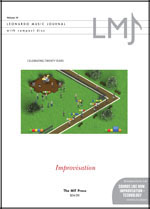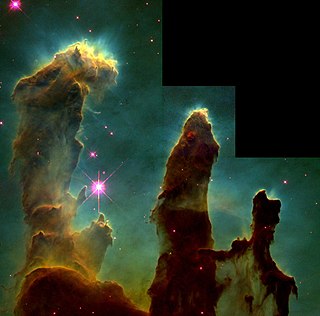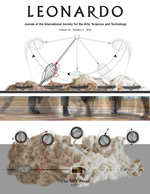
Electronic art is a form of art that makes use of electronic media. More broadly, it refers to technology and/or electronic media. It is related to information art, new media art, video art, digital art, interactive art, internet art, and electronic music. It is considered an outgrowth of conceptual art and systems art.

The MIT Press is a university press affiliated with the Massachusetts Institute of Technology (MIT) in Cambridge, Massachusetts. The Press has been a pioneer in the Open Access movement in academic publishing and publishes a number of academic journals. The organization also operates the MIT Press Bookstore, which is one of the few retail bookstores run by a university publisher.

Frank Joseph Malina was an American aeronautical engineer and painter, known for his pioneering work in early rocketry.

Experiments in Art and Technology (E.A.T.), a non-profit and tax-exempt organization, was established in 1967 to develop collaborations between artists and engineers. The group operated by facilitating person-to-person contacts between artists and engineers, rather than defining a formal process for cooperation. E.A.T. initiated and carried out projects that expanded the role of the artist in contemporary society and helped explore the separation of the individual from technological change.
William P. Parker is an American artist, scientist, and entrepreneur, best known for inventing the modern design of the plasma globe. The invention occurred in 1971, when Parker was working as a student in a physics laboratory at the Massachusetts Institute of Technology and accidentally filled a test chamber to a greater-than-usual pressure with ionized neon and argon. Three years later, Parker was artist-in-residence at the Exploratorium in San Francisco and created two installations using this technology, entitled Quiet Lightning and AM Lightning.

Leonardo Music Journal is an annual multimedia peer-reviewed academic journal published by the MIT Press on behalf of Leonardo, The International Society of the Arts, Sciences and Technology. The journal was established in 1991 and publishes the work of artists who are inventing media, implementing developing technologies, and expanding the boundaries of radical and experimental aesthetics. The journal is a companion volume to Leonardo. The editor-in-chief is Roger Malina.

"Space art", also known as "astronomical art", is the term for a genre of modern artistic expression that uses the universe as a frame of reference. Like other genres, space art has many facets and encompasses realism, impressionism, hardware art, sculpture, abstract imagery, and zoological art. Though artists have long produced art with astronomical elements, the genre of space art itself is still in its infancy, having begun only when technological advancement allowed for more detailed observation of the night sky. Regardless of style, space art attempts to communicate ideas somehow related to space, often including an artistic interpretation of varied cosmological phenomena and scientific discoveries. In some cases, artists who consider themselves space artists use more than illustration and painting to communicate astronomy or works depicting space, with some working directly with space flight technology and scientists in attempts to expand the arts, humanities, and cultural expression relative to space exploration.
BioArt is an art practice where artists work with biology, live tissues, bacteria, living organisms, and life processes. Using scientific processes and practices such as biology and life science practices, microscopy, and biotechnology the artworks are produced in laboratories, galleries, or artists' studios. The scope of BioArt is a range considered by some artists to be strictly limited to "living forms", while other artists include art that uses the imagery of contemporary medicine and biological research, or require that it address a controversy or blind spot posed by the very character of the life sciences.

Virtual art is a term for the virtualization of art, made with the technical media developed at the end of the 1980s. These include human-machine interfaces such as visualization casks, stereoscopic spectacles and screens, digital painting and sculpture, generators of three-dimensional sound, data gloves, data clothes, position sensors, tactile and power feed-back systems, etc. As virtual art covers such a wide array of mediums it is a catch-all term for specific focuses within it. Much contemporary art has become, in Frank Popper's terms, virtualized.

Edward A. Shanken is an American art historian, whose work focuses on the entwinement of art, science and technology, with a focus on experimental new media art and visual culture. Shanken is Professor, Arts Division, at UC Santa Cruz. His scholarship has appeared in numerous journals and anthologies and has been translated into many languages. Shanken is the author of Art and Electronic Media, among other titles.
Judy Malloy is a poet whose works embrace the intersection of hypernarrative, magic realism, and information art. Beginning with Uncle Roger in 1986, Malloy has composed works in both new media literature and hypertext fiction. She was an early creator of online interactive and collaborative fiction on The WELL and the website ArtsWire.

Lumino Kinetic art is a subset and an art historical term in the context of the more established kinetic art, which in turn is a subset of new media art. The historian of art Frank Popper views the evolution of this type of art as evidence of "aesthetic preoccupations linked with technological advancement" and a starting-point in the context of high-technology art. László Moholy-Nagy (1895–1946), a member of the Bauhaus, and influenced by constructivism can be regarded as one of the fathers of Lumino kinetic art. Light sculpture and moving sculpture are the components of his Light-Space Modulator (1922–30), One of the first Light art pieces which also combines kinetic art.

Hybrid art is a contemporary art movement in which artists work with frontier areas of science and emerging technologies. Artists work with fields such as biology, robotics, physical sciences, experimental interface technologies, artificial intelligence, and information visualization. They address the research in many ways such as undertaking new research agendas, visualizing results in new ways, or critiquing the social implications of the research. The worldwide community has developed new kinds of art festivals, information sources, organizations, and university programs to explore these new arts.

New media art includes artworks designed and produced by means of electronic media technologies, comprising virtual art, computer graphics, computer animation, digital art, interactive art, sound art, Internet art, video games, robotics, 3D printing, and cyborg art. The term defines itself by the thereby created artwork, which differentiates itself from that deriving from conventional visual arts. New Media art has origins in the worlds of science, art, and performance. Some common themes found in new media art include databases, political and social activism, Afrofuturism, feminism, and identity, a ubiquitous theme found throughout is the incorporation of new technology into the work. The emphasis on medium is a defining feature of much contemporary art and many art schools and major universities now offer majors in "New Genres" or "New Media" and a growing number of graduate programs have emerged internationally. New media art may involve degrees of interaction between artwork and observer or between the artist and the public, as is the case in performance art. Yet, as several theorists and curators have noted, such forms of interaction, social exchange, participation, and transformation do not distinguish new media art but rather serve as a common ground that has parallels in other strands of contemporary art practice. Such insights emphasize the forms of cultural practice that arise concurrently with emerging technological platforms, and question the focus on technological media per se. New Media art involves complex curation and preservation practices that make collecting, installing, and exhibiting the works harder than most other mediums. Many cultural centers and museums have been established to cater to the advanced needs of new media art.

Roger Malina is an American physicist, astronomer, Executive Editor of Leonardo Publications by Leonardo, the International Society of Arts, Sciences and Technology and distinguished professor of arts and technology, and professor of physics at the University of Texas at Dallas.
Adrianne Wortzel is an American contemporary artist who utilizes robotics in her installations and performances. She has also created many online works.
Physics outreach encompasses facets of science outreach and physics education, and a variety of activities by schools, research institutes, universities, clubs and institutions such as science museums aimed at broadening the audience for and awareness and understanding of physics. While the general public may sometimes be the focus of such activities, physics outreach often centers on developing and providing resources and making presentations to students, educators in other disciplines, and in some cases researchers within different areas of physics.
Lalya Gaye is a digital media artist and interaction designer whose early work was influential in the field of locative media. Currently based in Newcastle upon Tyne, UK, she is the founder and director of the international and interdisciplinary digital art practice Attaya Projects.
Leonardo, The International Society for the Arts, Sciences and Technology (Leonardo/ISAST) is a registered 501(c)(3) nonprofit formed in 1982 as an umbrella organization for the journals Leonardo and the Leonardo Music Journal. In 2018, Leonardo/ISAST was awarded the Golden Nica Prix Ars Electronica as Visionary Pioneers of New Media Art.

Ellen K. Levy is an American multimedia artist and scholar known for exploring art, science and technology interrelationships since the early 1980s. Levy works to highlight their importance through exhibitions, educational programs, publications and curatorial opportunities; often through collaborations with scientists including NASA, some in conjunction with Leonardo, the International Society for the Arts, Sciences and Technology. She is a past president of the College Art Association and has published widely on art and complex systems.













